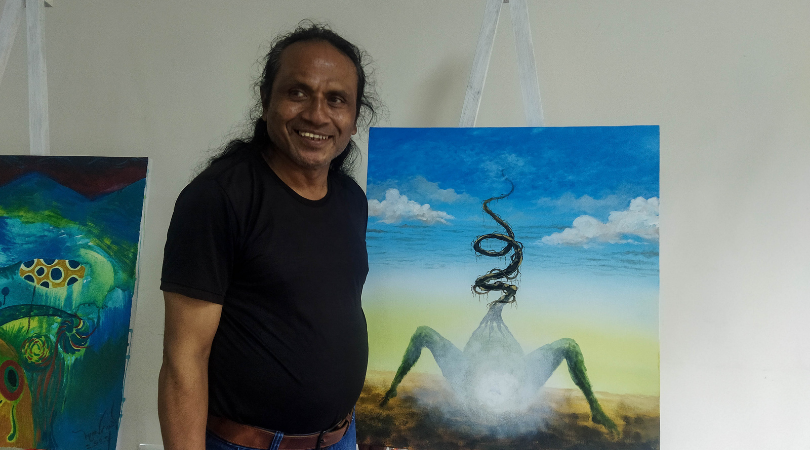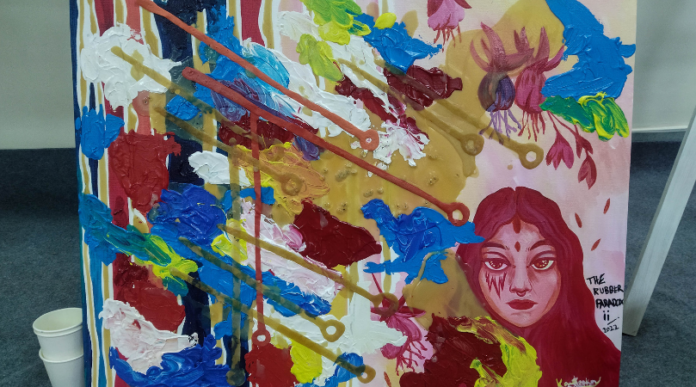MEDA MARWEIN
SHILLONG:
Positive Energy Art Foundation (PEAF) and Indian Council of Social Science Research-North East Regional Centre (ICSSR-NERC) concluded its five-day art workshop at NEHU with a display of performance and painting put together by twenty-six art renegades after their tryst in Shillong.
The five-day event on the main theme, ‘Cross-cultural Identities: Dialogue Through Art,’ began on July 4 where five countries came together to represent their racial, cultural identities through artistic presentation.
Day five on Friday witnessed perhaps one of the liveliest sessions the workshop could boast of. It was on the day that the artists came to life, their personalities written all over the canvases that were blank on the inauguration day.
Thailand’s Nawat Lertsawaengkit, one of the presenters who also happened to be one of the instructors of PEAF, walked through his painting of a young boy in Khasi traditional attire carrying a pineapple on his left hand, with the city of Shillong in the background.
He told The Meghalayan, that the painting was inspired by his ‘dialogues’ and ‘conversations’ with the people of Shillong.
“Every day I was offered pineapple by everyone in the area, somehow it struck me to imbibe it in my work and the boy in the painting is Kishore’s son who happened to be wearing the Khasi traditional attire. These small things come together to make the painting,” he said. The painting according to him is a rendition of the Greek mythical demigod Perseus holding Medusa’s head but instead of Perseus and Medusa’s head, a boy in Khasi attire and a pineapple replaced the two. This is an impeccable example of cross-cultural identities or hybridity that the workshop wanted to emphasise.
The Rubber Paradoxii by Kaewtrakan Kunlabon, who is also from Thailand, is one of those artworks that catches your eye the instant you walk into the room. She meshed colour and rubber to mould her art in a way that speaks of how unapologetic she is. Her artwork portrayed a fiery and passionate woman who is in tune with her roots and modernity.
“There’s something about this place that feels like a home away from home. The rain, the mountains I see around brings me closer to my roots, there’s a similarity I couldn’t shake off. Despite the distance between my country and this place, this painting resembles my home. Well, let’s just say art ties everyone together,” she shyly stated.

Pipat Saksirikasemkul, from Thailand, spoke of his love for history and watercolours. He says his expertise is in architectural pieces and while he’s teaching students he would take them out on trips to historical places, in these places, he said.
“I marry art and architectural history through watercolour as the medium to bring in calm, serene picturesque landscapes that speak of an aging cultural identity that should be forever preserved,” he said.
Local artists, Raphael Warjri, Benedict Hynniewta and Phaibhakupar Kharlukhi, shared their experiences on these four walls of ICSSR and their paintings were exquisite masterpieces of their own.
On the far corner of the gallery sits Warjri’s painting that sings of lore, birth, rebirth and the cyclical nature of the world in its entirety.
“The painting is multilayered, it’s a birthing of myths, humanity, the natural and even the supernatural. I titled it ‘Life’. It depicts the world as we know; a common phenomenon of birth and rebirth that every culture in the world shares, humans and nature alike, time and time again,” he said.
Benedict Hynniewta’s is a self-portrait, he says and starts to peel the many layers of his art work.
“The painting is a self-portrait but I have feminised the features to make it softer perhaps to showcase a state of mind. The negative and positive energies of life can shape a man. It’s up to us to snap out of it and either embrace the vibrant energy of life or the negativity.” Hynniewta says his experience has made him embody the varied cultures art has honed and developed and says that workshop like these could empower artists to translate their identities and ethnicities.
Phaibhakupar Kharlukhi, who is a landscape artist, deviated from his usual pieces. “It’s a union among three components. Perhaps it might complicate the spectator but it is at workshops like these that we get to be as radical as possible and be our inherent selves and just embody art in all its glory.”
The art gallery was a treat to look at, from landscape art to the abstract, each canvas evoked multiple emotions. The event ended with a vote of thanks and a valedictory address, with PEAF saying that there will be more workshops like these in Southeast Asia that will cater to the artists of the region.


